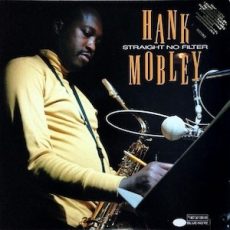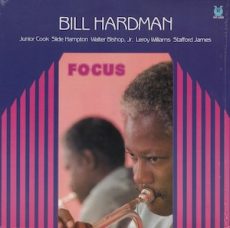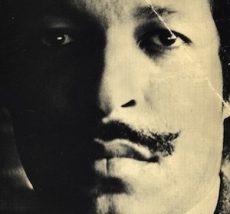
Jazz Poems
POEM IN WHICH I MAKE THE MISTAKE
OF COMPARING BILLIE HOLIDAY TO A
COSMIC WASHERWOMAN
We were driving back from the record store at the mall
when Terrance told me that Billie Holiday
was not a symbol for the black soul.
He said, The night is not African American either for
your information,
it is just goddamn dark,
and in the background
she was singing a song I never heard before
moving her voice like water moving
along the shore of a lake
reaching gently into the crevices, touching the pebbles
and sand.
Once through the dirty window of a train
on the outskirts of Hoboken, New Jersey,
I swear I saw a sonnet written high up in a
concrete wall,
rhymed quatrains rising from the
dyslexic alphabet of gang signs and obscenities
and Terrance said he saw a fresco
of brown and white angels flying
on a boarded-up building in Chinatown
and everybody knows
there’s a teenager genius somewhere out there,
a firebrand out of Ghana by way of Alabama,
this very minute in a warehouse loft,
rewriting Moby-Dick-The Story of the Great
Black Whale
When he burst out of the womb
of his American youth
with his dictionary and his hip-hop shovel,
when he takes his place on stage
dripping the amniotic fluid of history,
he won’t be any color we ever saw before,
and I know he’s right, Terrance is right, it’s
so obvious
But here in the past of that future,
Billie Holiday is still singing
a song so dark and slow
it seems bigger than her, it sounds very heavy
like a terrible stain soaked into the sheets,
so deep that nothing will ever get it out,
but she keeps trying,
she keeps pushing the dark syllables under the water
then pulling them up to see if they are clean
but they never are
and it makes her sad
and we are too
and it’s dark around the car and inside also is very
dark
Terrance and I can barely see each other
in the dashboard glow.
I can only imagine him right now
pointing at the radio
as if to say, Shut up and listen.
TONY HOAGLAND | 1953~2018
from Jazz Poems ~ Selected and Edited by Kevin Young
More Posts: book,classic,collectible,history,jazz,library,poet

Requisites
Straight No Filter ~ Hank Mobley | By Eddie Carter 5.4.25
This morning’s album from the library is one of my favorites by tenor man Hank Mobley. Straight No Filter (BlueNote BST 84435) is a 1986 release of previously unreleased tracks culled from three sessions in 1963, 1965, and 1966. Hank composed all the tracks on this album. He’s joined by Donald Byrd (track: B3), Freddie Hubbard (B1,B2), and Lee Morgan (A1 to A3) on trumpet, Herbie Hancock (B3), Barry Harris (B1, B2), and McCoy Tyner (A1 to A3), Paul Chambers (B1, B2), Bob Cranshaw (A1 to A3), and Butch Warren (B3) on bass, Billy Higgins (A1 to B2), and Philly Joe Jones (B3) on drums. My copy is the U.S. Direct Metal Mastering stereo release.
The title track, Straight No Filter, kicks off the album with the rhythm section’s lively introduction to the ensemble’s melody. Hank launches into the opening statement. Lee maintains the spirited groove in the following solo, and then McCoy takes the energy to a new level. Hank and Lee exchange a few choruses, leading back to the theme and climax. Chain Reaction starts swiftly from the trio’s introduction into the front line’s uptempo theme. Tyner leads the way with an infectiously energetic solo. Morgan swings into the second solo with considerable zest and a bright tone, then Mobley soars briskly through the finale into the theme’s restatement and a slow fade.
Soft Impressions opens with the rhythm section setting a soothing mood for the quintet’s theme. Hank establishes a smooth and easy groove in the opening statement. Lee adds to the relaxing atmosphere in the second interpretation, and then McCoy’s closing solo is as refreshing as an oasis in the desert until the theme’s reprise and climax. Third Time Around begins the second side with Chambers’s introduction ahead of the group’s medium melody. Mobley gets right down to business in the lead solo, then Hubbard provides a beautifully executed statement. Harris provides a pleasantly relaxing reading next, and Chambers walks with a bluesy bounce before the closing ensemble exits.
Hank’s Waltz is a catchy blues that Barry introduces ahead of the ensemble’s entrance. Hank breaks the ice with an infectious swing, then Lee adds a spicy touch in the second solo. Barry further elevates the mood in the final statement, before the theme is revisited and the rhythm section gently fades out. The group serves up a delicious plate of Syrup and Biscuits for the album’s finale. After the engaging theme is established, Mobley fires up the joyful energy in the opening solo. Byrd maintains a cheerful vibe in the following performance. Both horns engage in a vibrant exchange preceding the closing chorus.
Alfred Lion produced the original sessions, and Michael Cuscuna produced this release. Rudy Van Gelder was behind the dials on each date. The album boasts an excellent soundstage, transporting the musicians to the sweet spot in your listening room. Mobley was one of the best tenor men in jazz, with an outstanding discography as both leader and sideman. If you enjoy hard bop, consider adding Straight No Filter by Hank Mobley to your list on your next vinyl hunt. It’s a delightful surprise featuring some excellent playing by Hank and his bandmates across three stellar sessions, making it a highly recommended addition to any jazz library!
© 2025 by Edward Thomas Carter
More Posts: choice,classic,collectible,collector,history,instrumental,jazz,music,saxophone

Jazz Poems
STARDUST
Lady singsthe blues
the reds, whatever
she can find—
short
changed, a chord—
God bless
the child
that’s got his own
& won’t mind
sharing some—
“BILLIES BOUNCE”
“BILLIES BOUNCE”
Miss Holiday’s up
on four counts
of possession, three-
fifths, the law
—locked up—
licked—the salt
the boot—refused
a chance to belt
tunes in the clubs—
ex-con. Man,
she got it
bad—Brother
can you spare
a dime
bag? MEANDERING
WARMING UP
A RIFF—
she’s all scat,
waxing—
SIDE A
SIDE B
OOH
SHOO DE
OBEE—
detoxec, thawed
in time
for Thanksgiving—live
as ammo, smoking
—NOV. 26 1945—
Day cold as turkey
KEVIN YOUNG
from Jazz Poems ~ Selected and Edited by Kevin Young
More Posts: book,classic,collectible,history,jazz,library,poet

Requisites
Focus ~ Bill Hardman | By Eddie Carter
This morning’s discussion is a terrific album by Bill Hardman. Focus (Muse Records MR 5259) is his fourth release as a leader, and a hidden gem in his catalog. Bill was born and raised in Cleveland, Ohio, where his jazz journey began playing with Tadd Dameron while in high school, and after graduating, with Tiny Bradshaw. His first recording with Jackie McLean in 1956 marked the beginning of a career that, although not widely known, earned deep respect in jazz circles for his exceptional trumpet and flugelhorn performances. On this album, Bill’s trumpet is joined by Slide Hampton on trombone (tracks: A2, A3, B1, B3), Junior Cook on tenor sax, Walter Bishop Jr. on piano, Mark Elf on guitar (B2), Stafford James on bass, and Leroy Williams on drums. My copy is the 1980 U.S. stereo release.
Side One is off to the races with Avila & Tequila by Hank Mobley. Leroy opens with a spirited introduction, accompanied by Walter and Stafford, setting the stage for the ensemble’s collective theme. Bill soars through the opening solo energetically. Junior’s following statement is brimming with dynamic energy. Walter maintains the vigorous momentum next, and Leroy charges the finale in a short workout, culminating in the theme’s reprise and fadeout. The sextet eases into the medium melody of Cubicle by Walter Bishop Jr. Bill gets into a good groove on the lead solo. Slide has an outstanding moment before Junior takes over to put his ideas into practice. Walter wraps it up before the restatement and exit.
Up next is Bill Lee’s Too Little, Too Late. The sextet’s medium-tempo introduction and melody start things off. Bill gets things going with a relaxing interpretation, then Slide moves with unhampered ease in the following solo. Junior jumps into a short, articulate statement next, and Walter wraps things up with a satisfying conclusion, preceding the closing chorus. The title tune, Focus by Tadd Dameron, changes the direction to begin the second side with the ensemble’s upbeat introduction and theme in unison. Slide steps up first to give a lively solo. Junior glides over the rhythm section with agility and skillful confidence next, then Bill attacks the following reading with virile lyricism. Walter continues conveying happy thoughts on the piano, and Stafford takes a short walk leading to the ending theme.
My One and Only Love by Robert Mellin and Guy Wood begins with Walter’s introduction, setting the mood for Bill’s tender melody with Junior shadowing him as it unfolds. Junior tells a touching story in the opening statement, then Mark delivers notes of great beauty in his only solo spotlight. Bill follows with a passionately haunting interpretation preceding his return to the gentle ending theme and soft climax. Minority by Basheer Qusim takes off like a race car with Leroy leading the sextet into a speedy melody. Bill goes to work first with a spirited solo, then Junior cooks at the right temperature. Slide infuses the following reading with riveting urgency. Walter builds the following statement exquisitely, and Leroy shines in a short workout before the melody’s restatement and finale.
Fred Seibert produced Focus, and the recording engineer was Fred Miller. The album is a joy to listen to, with a superb soundstage that brings the musicians to the sweet spot in your listening room with stunning fidelity. Bill Hardman recorded only five albums as a leader, but his discography as a sideman is extensive, including with Art Blakey and The Jazz Messengers, Lou Donaldson, Charles Mingus, and Horace Silver. He also co-led a group with Junior Cook but ultimately remained little known to the general public. He died on December 6, 1990, from a brain hemorrhage at age fifty-seven. If you’re a hard bop fan, I invite you to check out Focus by Bill Hardman on your next vinyl hunt. It’ll reward you with many hours of listening pleasure, especially if you’re a fan of jazz trumpet!
~ Jackie’s Pal (Prestige PRLP 7068) – Source: Discogs.com
~My One and Only Love – Source: JazzStandards.com
© 2025 by Edward Thomas Carter
More Posts: choice,classic,collectible,collector,flugelhorn,history,instrumental,jazz,music,trumpet

Jazz Poems
GYRE’S GALAX
Sound variegated through beneath lit
Sound variegated through beneath lit through sound beneath variegated lit sound variegated through beneath litVariegated sound through beneath lit dark
Variegated sound through beneath lit dark sound variegated through beneath lit variegated sound through beneath lit darkThrough variegated beneath sound lit
Through variegated beneath sound lit through variegated beneath sound lit through variegated beneath sound lit Through variegated beneath sound lit Through variegated beneath sound lit through beneath lit through beneath lit through beneath lit through beneath lit Thru beneath Thru beneath Thru beneath through beneath lit Thru beneath through beneath lit Thru beneath through beneath lit Thru beneath Thru beneath through beneath lit Thru beneath Thru beneath through beneath lit Thru beneath Thru beneath Thru beneath Thru beneath Thru beneath Thru beneath Thru beneath Through beneath litTwainly simple of amongst
twainly simple of amongst Twainly simple of amongst twainly simple of amongst Twainly simple of amongst twainly simple of amongst In lit black viewly viewly viewly in viewly viewly viewly in viewly viewly in viewly viewly in viewly viewly viewly viewly in viewly viewly In lit black viewly in dark to stark In dark to stark In dark to stark in dark to stark In dark to stark in dark to stark In dark to stark In above beneath In above beneath In above beneath above beneath lit above beneath above beneath above beneath above beneath lit above beneath above beneath lit above beneath above beneath lit above beneath above beneath lit above beneath above beneath above beneath above beneath above beneath lit above beneath above beneath above beneath lit above beneath above beneath above beneath above beneath above beneath above beneath above beneath above beneath above beneath litN. H. PRITCHARD
from Jazz Poems ~ Selected and Edited by Kevin Young
More Posts: book,classic,collectible,history,jazz,library,poet



